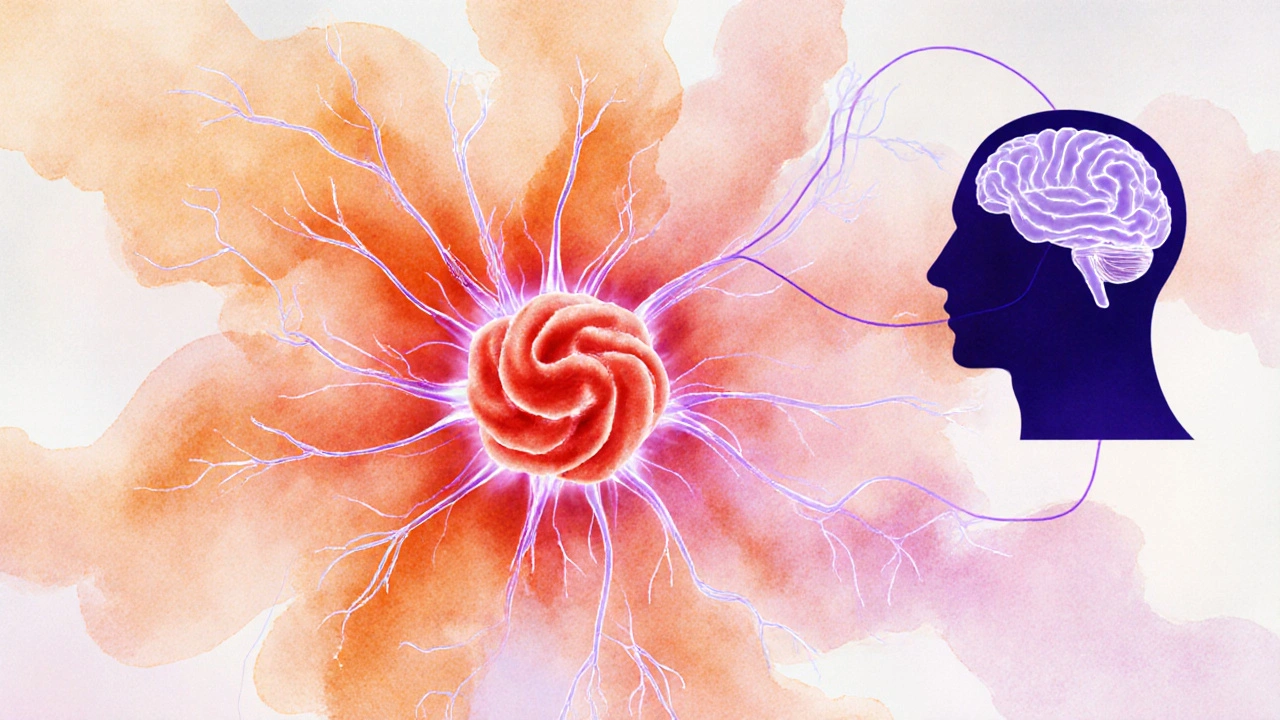
Muscle Stiffness & Chronic Pain Impact Calculator
Your Risk Assessment
What This Means
The calculator evaluates how muscle stiffness may contribute to chronic pain development. Higher scores indicate increased risk of transitioning from acute stiffness to persistent pain conditions.
When muscle stiffness feels like a constant tightness that limits movement and makes everyday tasks feel harder, many people assume it’s just a minor nuisance. In reality, that tightness can be a gateway to long‑lasting aches that don’t go away on their own. If you’re dealing with muscle stiffness, you’re probably wondering why the ache lingers and how to break the cycle.
Key Takeaways
- Muscle stiffness and chronic pain share overlapping biological pathways.
- Conditions like fibromyalgia, myofascial pain syndrome, and osteoarthritis often start with or worsen because of stiff muscles.
- Trigger points, nerve sensitisation, and low‑grade inflammation are the main culprits.
- Regular stretching, targeted therapy, and lifestyle tweaks can dramatically reduce both stiffness and pain.
- Seek professional help when stiffness lasts more than a few weeks or is accompanied by numbness, weakness, or severe pain.
What Exactly Is Muscle Stiffness?
Simply put, muscle stiffness is the sensation that a muscle or a group of muscles won’t relax fully. It often shows up after intense exercise, a night of poor sleep, or prolonged sitting. The affected area feels hard to the touch, moves less freely, and may produce a dull ache when you press on it.
Stiffness differs from a short‑term cramp because it lasts for hours, days, or even weeks. It can appear anywhere-neck, shoulders, lower back, hips, or calves-but it’s most common in the upper back and lumbar region.
How Stiff Muscles Jump‑Start Chronic Pain
Chronic pain is defined as pain that persists longer than three months or beyond the normal healing time of an injury. The link between ongoing stiffness and chronic pain isn’t just coincidence; they often feed each other.
When a muscle stays tight, it can compress surrounding nerves, limit blood flow, and create micro‑tears in the surrounding fascia. Those micro‑tears trigger a cascade of signals that tell the brain “something is wrong,” even after the original cause has faded.
Over time, the nervous system becomes hypersensitive-a state known as nerve sensitisation where the spinal cord and brain amplify pain signals, making minor sensations feel painful. This heightened state is a core feature of many chronic pain conditions.

Conditions That Commonly Pair Stiffness with Chronic Pain
Below are three of the most frequently mentioned disorders where muscle stiffness plays a starring role.
- Fibromyalgia a widespread pain syndrome marked by tender points, fatigue, and sleep problems. Patients often describe “tight bands” around their torso that worsen flare‑ups.
- Myofascial pain syndrome a condition where painful “trigger points” develop within tight bands of muscle. The trigger points can radiate pain far from their origin and keep muscles perpetually stiff.
- Osteoarthritis degenerative joint disease that often causes the muscles around the joint to tighten in an effort to protect it. The resulting stiffness limits joint motion and adds to joint pain.
The Biology Behind the Link
Three biological mechanisms most people overlook:
- Trigger points: Small, hyper‑irritable knots that form in stiff muscle fibers. When pressed, they send pain signals that travel along nerves, creating a map of pain far beyond the knot itself.
- Low‑grade inflammation: Stiff muscles can release inflammatory mediators like cytokines. Even a mild, sustained inflammation keeps pain receptors on high alert.
- Altered proprioception: Muscle tightness impairs the body’s sense of position, making the brain over‑compensate with protective muscle guarding, which further tightens the muscles.
These mechanisms intertwine, turning a simple tightness into a full‑blown pain‑maintenance loop.
Practical Strategies to Loosen Up and Lighten Pain
Breaking the cycle doesn’t require a doctorate-consistent, targeted habits are enough for most people.
- Stretching gentle, static stretches held for 20-30 seconds to lengthen tight muscle fibers. Aim for a daily routine covering the neck, shoulders, hips, and calves.
- Massage therapy manual pressure that helps break down trigger points and improve blood flow. A 30‑minute session once a week can dramatically cut stiffness.
- Physical therapy guided exercises that focus on strength, flexibility, and motor control. Therapists can teach you self‑myofascial release using foam rollers or tennis balls.
- Yoga a mind‑body practice that combines gentle stretching, breathing, and relaxation. Regular classes improve muscle elasticity and reduce stress‑driven tension.
- Aerobic exercise low‑impact activities like walking, cycling, or swimming that raise body temperature and promote circulation. Moving the body for 20-30 minutes most days helps flush out inflammatory chemicals.
Combine at least two of these approaches each week and track how your stiffness and pain scores change. Small improvements add up quickly.

When to Seek Professional Help
If the tightness lasts more than three weeks, worsens despite home care, or comes with any of these red flags, it’s time to book an appointment:
- Numbness, tingling, or weakness in the arms or legs.
- Sudden, severe pain that doesn’t improve with rest.
- Fever, unexplained weight loss, or swelling around a joint.
- Persistent pain that interferes with sleep or daily activities.
Healthcare providers may order imaging, blood tests, or refer you to a specialist such as a rheumatologist, neurologist, or pain physician.
Quick Comparison: Muscle Stiffness vs Chronic Pain Conditions
| Aspect | Muscle Stiffness | Chronic Pain Condition |
|---|---|---|
| Typical Duration | Hours to weeks | Months to years |
| Primary Cause | Mechanical overload, poor posture | Complex mix of neurological, inflammatory, and psychological factors |
| Common Symptoms | Tightness, limited range of motion | Persistent ache, hyper‑sensitivity, fatigue |
| Key Treatment | Stretching, massage, activity modification | Multimodal therapy - meds, physical rehab, cognitive strategies |
| Linkage | Can trigger or amplify chronic pain | Often worsened by ongoing stiffness |
Frequently Asked Questions
Can occasional muscle stiffness lead to chronic pain?
Yes. Repeated episodes of tight muscles can cause trigger points and low‑grade inflammation, both of which sensitize nerves. Over time, this can evolve into a chronic pain state if not addressed.
Is stretching enough to stop the pain cycle?
Stretching helps, but the most effective approach combines stretching with strengthening, manual therapy, and regular movement to keep blood flow and nerve signaling balanced.
What are trigger points and how do they relate to stiffness?
Trigger points are tiny knots in a tight muscle fiber that stay contracted even at rest. They send pain signals outward, creating referred pain and keeping the surrounding muscle stiff.
Should I take pain medication for muscle stiffness?
Occasional NSAIDs can reduce inflammation, but they don’t solve the underlying tightness. Use meds as a short‑term bridge while you adopt stretching, therapy, and movement habits.
How long does it take to see improvement?
Most people notice reduced tightness within 1‑2 weeks of consistent stretching and self‑massage. Complete pain reduction can take 4‑6 weeks, especially if chronic conditions are involved.

14 Comments
Muscle stiffness is not merely a mechanical nuisance, it is a subtle messenger of our body's deeper narrative.
When fibers linger in a state of tautness, they broadcast a signal that the nervous system may interpret as threat.
Over time this persistent alarm can rewrite the brain's pain circuitry, fostering chronic sensitization.
The phenomenon resembles a vicious circle where tension breeds pain, and pain invites more tension.
Philosophically, this loop mirrors our tendency to ruminate on discomfort, amplifying its impact.
Scientific studies show that prolonged myofascial contraction reduces blood flow, depriving tissues of oxygen and nutrients.
Such hypoxia triggers inflammatory pathways, which further irritate nociceptors.
Consequently, even mild stiffness can evolve into a lingering ache that outlasts the original insult.
The calculator presented in the article attempts to quantify this risk, yet numbers alone cannot capture lived experience.
It is essential to pair quantitative tools with qualitative self‑awareness, listening to how the body feels each day.
Regular mobility work, gentle stretching, and mindful breathing can interrupt the feedback loop.
These practices restore perfusion, relax spindle activity, and signal safety to the central nervous system.
Moreover, addressing psychosocial stressors that heighten muscle tone can diminish the probability of chronic pain.
In short, stiffness is a symptom, not a fate; proactive care can transform a potential chronic condition into a transient inconvenience.
Remember, the body is adaptable, and with consistent attention, the cycle of stiffness and pain can be broken.
Looks like the whole “muscle stiffness” hype is just another way for the pharma lobby to push more supplements.
They hide the real agenda behind cute sliders and risk scores.
Wake up, people – it’s all about controlling the masses through health anxiety.
Don’t trust any “calculator” that claims to know your body.
Stay skeptical and keep your mind off the mainstream narratives.
While some love to see conspiracies everywhere, the truth is that chronic pain often stems from neglectful medical advice.
Doctors frequently prescribe quick fixes instead of addressing underlying stiffness.
It’s a moral failing that leaves patients suffering longer than necessary.
The pathophysiology of myofascial tension involves mechanotransduction pathways, integrin signaling, and cytokine release.
Elevated gamma‑aminobutyric acid (GABA) antagonism in the dorsal horn can potentiate nociceptive transmission.
Incorporating proprioceptive feedback loops via neuromuscular re‑education can attenuate hyperexcitability.
Algorithmic risk models, like the one displayed, must integrate biomechanical parameters for validity.
Without accounting for viscoelastic hysteresis, any score remains a superficial proxy.
Thus, interdisciplinary approaches are paramount for accurate prognostication.
Oh great, another shiny widget that tells you you're probably going to be a human pretzel.
Because nothing says “helpful” like a digital fortune teller for your aches.
Honestly, the intent behind the tool is to empower users with a visual cue, not to mystify them.
It can spark a conversation with a physiotherapist about targeted interventions.
Just remember that data is a guide, not a verdict.
Use it as a stepping stone toward informed self‑care.
I’ve seen many folks struggle with lingering stiffness after a rough workout, and the key is consistency.
Gentle dynamic stretches each morning can improve fascia glide.
Pair that with progressive load management, and you’ll likely notice less pain over weeks.
Listening to your body’s signals is the most compassionate thing you can do.
Sure, calculators are the ultimate truth‑seeker, right?
Let’s all abandon personal experience for a slider.
Your punctuation is egregiously incorrect.
Well, I guess the point is that even tiny errors can distract readers
so maybe we should focus more on content than on flawless commas
but still, a little care goes a long way
Hey team, let’s get moving!! Consistent mobility drills are the secret sauce!! Even five minutes a day can reset the nervous system!! Trust the process and watch stiffness melt away!!
Nice tool! 👍🙂
In reviewing the presented risk assessment, it becomes evident that a multidisciplinary strategy is advisable.
Collaboration among physical therapists, pain specialists, and mental health professionals can address both somatic and psychosocial contributors.
Patients are encouraged to integrate graded exercise with cognitive coping mechanisms.
This comprehensive plan enhances resilience against chronic pain development.
Honestly, I skimmed through the whole thing and it seemed like a lot of fluff wrapped in a glossy interface.
The idea of plugging numbers into a slider and getting a “risk level” feels superficial.
Sure, it might raise awareness, but without actionable steps it just adds another layer of anxiety.
Maybe the developers should focus on delivering concrete stretch routines instead of vague scores.